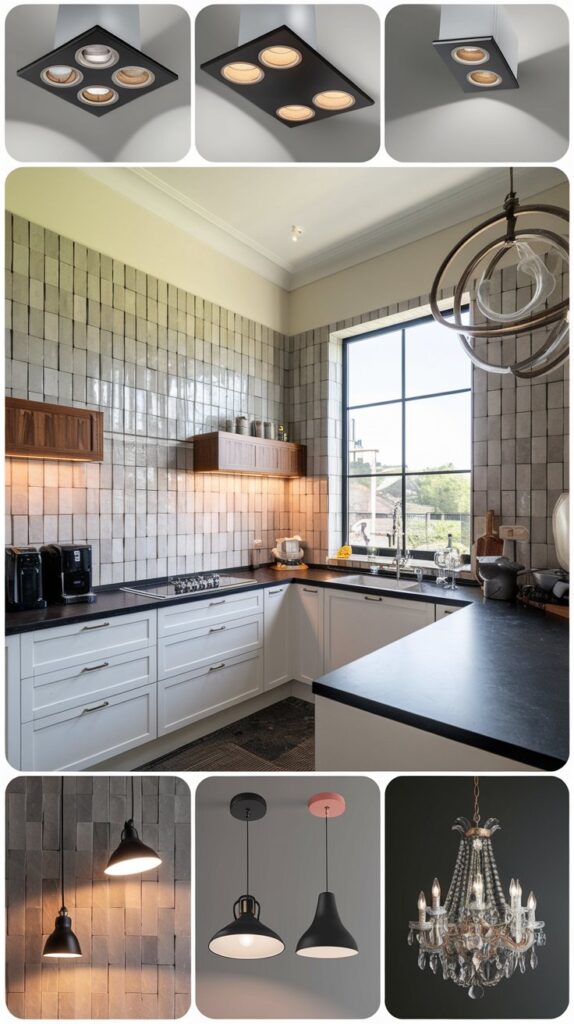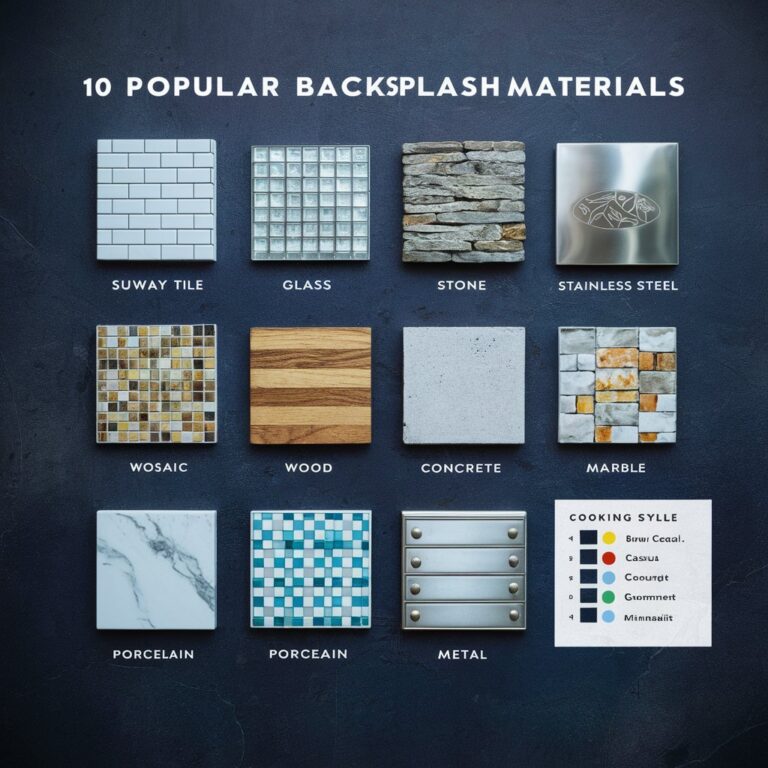Your kitchen is more than a space for cooking—it’s the heart of your home where functionality meets aesthetics. Lighting plays a pivotal role in creating a space that’s both practical and stylish. The right lighting enhances your kitchen’s layout, complements its design style, and improves its overall ambiance. Whether you’re working with a galley kitchen, an open-concept space, or a classic farmhouse design, selecting the ideal lighting fixtures requires careful planning.
In this guide, we’ll explore the types of kitchen lighting and how to match them with your kitchen’s layout and style.

1. Understanding the Three Layers of Kitchen Lighting :

To create a well-lit, balanced kitchen, you need a mix of three essential lighting types:
A. Ambient Lighting (General Lighting)
Ambient lighting provides overall illumination, ensuring your kitchen feels bright and welcoming. Ceiling-mounted lights, recessed lighting, or large pendant lights can serve as your main light source. This layer eliminates dark corners and serves as the foundation of your lighting plan.
B. Task Lighting
Task lighting focuses on specific areas where you perform kitchen activities like cooking, chopping, and washing. Under-cabinet LED strips, track lighting, and pendant lights are popular choices for task lighting. Well-placed task lights improve visibility and reduce eye strain.
C. Accent Lighting
Accent lighting highlights architectural details, decor, or focal points in your kitchen, such as cabinets, backsplashes, or islands. This layer creates depth and visual interest. Consider toe-kick lighting, cabinet interior lighting, or decorative sconces for a sophisticated touch.
2. Matching Lighting to Your Kitchen Layout :

Different kitchen layouts require specific lighting strategies to ensure the space feels cohesive and functional. Here’s a breakdown based on common kitchen layouts:
A. Galley Kitchen
Galley kitchens are narrow, with countertops and cabinetry along two parallel walls. Effective lighting ensures that this compact space feels open and bright.
- Recessed Lighting: Install evenly spaced recessed lights along the ceiling to avoid shadows and ensure uniform brightness.
- Under-Cabinet Lights: LED strips under cabinets illuminate countertops, making food prep easier.
- Pendant Lights: Add visual interest with two small pendant lights over a narrow kitchen island (if present).
Tip: Use cool white bulbs to maximize brightness in the compact space.
B. L-Shaped Kitchen
The L-shaped layout combines flexibility with openness. Focus on lighting the two work zones efficiently.
- Recessed or Flush-Mount Ceiling Lights: Provide overall illumination across the room.
- Under-Cabinet Task Lights: Brighten countertops along the “L” for focused task lighting.
- Pendant Lighting: Hang a statement pendant light over the corner of the L or a small dining nook for added style.
Tip: Adjustable track lights allow you to direct illumination to both arms of the L-shaped layout.

C. U-Shaped Kitchen
U-shaped kitchens offer ample counter space and cabinetry on three walls, requiring layered lighting to prevent shadows.
- Layered Ceiling Lights: Combine recessed lighting with a flush-mount fixture for ambient lighting.
- Under-Cabinet Task Lighting: Install LED strips along all three countertop edges.
- Accent Lighting: Add glass cabinet lights or a decorative fixture at the kitchen center to balance the space.
Tip: A central chandelier or statement fixture anchors the U-shape, adding a focal point.
D. Island or Open-Concept Kitchen
Open-concept kitchens with islands are a focal point in modern homes. The lighting should define zones while maintaining visual harmony.
- Pendant Lights Over Islands: Hang 2–3 pendant lights for task lighting and visual appeal. Choose fixtures that match your kitchen’s design style.
- Recessed or Track Lighting: These ensure uniform illumination across the open space.
- Under-Cabinet LEDs: Illuminate prep zones and provide subtle light in the evenings.
- Accent Lighting: Add soft lighting under the island or above cabinets to create a cozy atmosphere.
Tip: Dimmable fixtures allow you to adjust the lighting based on time of day or mood.
3. Selecting Lighting for Your Kitchen Style :

Your lighting choices should complement your kitchen’s overall style, whether it’s modern, traditional, industrial, or farmhouse-inspired.
A. Modern Kitchens
Modern kitchens emphasize clean lines, minimalism, and sleek finishes.
- Linear Pendants: Sleek and geometric pendant lights over the island add sophistication.
- Recessed Lighting: Maintain a clutter-free ceiling with flush or recessed lights.
- LED Strips: Use cool-toned LED strips under cabinets or shelves for a contemporary look.
Best Material/Finish: Chrome, brushed nickel, or matte black.
B. Farmhouse Kitchens
Farmhouse-style kitchens embrace rustic charm and warmth.
- Lantern-Style Pendants: Hang rustic lantern lights or glass jar pendants above islands.
- Chandeliers: A wrought-iron or wood chandelier over the dining nook adds character.
- Warm LED Bulbs: Use warm white bulbs for a cozy, vintage glow.
Best Material/Finish: Wood, bronze, or aged metal.
C. Industrial Kitchens
Industrial kitchens showcase raw, unfinished elements like exposed beams and concrete.
- Exposed Bulb Pendants: Edison bulbs in black or metal fixtures add an urban edge.
- Track Lighting: Adjustable black track lights highlight work zones and decor.
- Metal Shades: Consider matte black or galvanized steel shades for island lighting.
Best Material/Finish: Metal, steel, or concrete finishes.
D. Traditional Kitchens
Traditional kitchens highlight classic details and elegance.
- Glass Chandeliers: Install a decorative chandelier or crystal pendant over islands.
- Flush-Mount Lights: Use classic fixtures with ornate details for ambient lighting.
- Candle-Style Sconces: Add vintage-style sconces for accent lighting.
Best Material/Finish: Polished brass, bronze, or glass.
4. Choosing the Right Bulbs for Your Kitchen :

Bulb selection is just as important as the fixtures. Here’s what to consider:
- Color Temperature:
- Warm White (2700K–3000K): Best for cozy, inviting spaces (farmhouse or traditional kitchens).
- Cool White (3500K–4100K): Ideal for task lighting and modern kitchens.
- Daylight (5000K+): Offers crisp, bright light for food prep zones.
- Energy Efficiency: Opt for LED bulbs to save energy and reduce heat output.
- Lumens: A well-lit kitchen typically requires 3000–4000 lumens overall.
Tip: Install dimmers to adjust brightness for different activities and moods.
5. Final Tips for a Well-Lit Kitchen :

- Mix and Match: Combine multiple types of lighting for a balanced and layered effect.
- Focus on Zones: Define specific areas like prep zones, islands, and dining spaces with distinct lighting.
- Add Smart Features: Smart bulbs or fixtures with dimmers and color-changing options can elevate functionality.
- Consider Height: Install pendant lights 30–36 inches above kitchen islands for ideal placement.
Conclusion:
The perfect kitchen lighting blends practicality and design. Whether you’re working with a cozy galley kitchen or a sprawling open-concept layout, layering ambient, task, and accent lighting ensures your space is both functional and inviting. Match your fixtures to your kitchen style—be it modern, farmhouse, or industrial—and choose the right bulbs to set the perfect mood.
A well-lit kitchen doesn’t just enhance your cooking experience; it transforms your space into a warm and stylish hub for family and friends.
Would you like me to refine this, add more examples, or focus on a specific kitchen layout?







